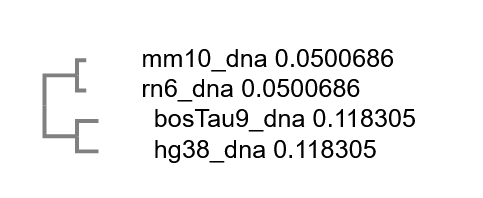He is referring to a different data set then where the hypothesis is primate species are separately created.
What real world sequence data produces a star phylogeny?
The sequence data that is generated when you look at alpha actin and the highly similar proteins among mammals. Many more examples available.
Why wouldn’t this star pattern hold for sequences that are not highly conserved? Shouldn’t your prediction hold for all sequences?
Citation needed.
I’m still waiting for you to even explain what a star tree is, in your own words.
I am unable to determine what you are trying to say there. Please try again.
No you haven’t, or if you had you expressed yourself so badly that I didn’t recognize it. First, you need to present an actual creation model. You have ignored all requests to do so. You will ignore this.
Show me the alpha actin phylogeny. Show me the other examples.
The sequence data that is generated when you look at alpha actin and the highly similar proteins among mammals.
Bill,
When I look at actin, it’s usually fluorescently stained in a cell, or a pellet from a purification, or a band on an SDS-PAGE gel.
I have no idea how you think that we can generate sequence data by looking at a protein. Silly me–I’ve only generated sequence data by sequencing nucleic acids, not by looking at proteins. Proteins themselves can be sequenced, but it’s a PITA and there’s no reason to for this context.
Can you explain, in detail, what you are trying to say here? It makes no sense to me.
And lets see the star phylogeny you have allegedly seen from actin sequences. Not word salad, this alleged phylogeny itself.
Show me the alpha actin phylogeny. Show me the other examples
If this is what you are looking for you can generate the non nested or poorly nested data yourself in uniprot. Try beta catenin, and the gene you used in your Croc paper MYC.
There’s no phylogeny in that PDF.
There is, it’s just a polytomy. Or, there was, but he uploaded a version that cropped out the edge. Bill is still under the impression that you can take 4 fairly closely related organisms, align an extremely conserved gene, and get an informative phylogeny.
There is, it’s just a polytomy. Or, there was, but he uploaded a version that cropped out the edge.
Either way, it suggests that Bill doesn’t get it.
Bill is still under the impression that you can take 4 fairly closely related organisms, align an extremely conserved gene, and get an informative phylogeny.
Bill, when protein sequences are so closely related that they aren’t useful, why wouldn’t you try their cDNA sequences? Or even the total gene sequences, including introns? Do you predict a nested hierarchy or a star phylogeny in those cases?
Apparently Bill isn’t aware he used the cardiac muscle instead of skeletal muscle protein from rat. Anyway, it’s 100% conserved in mammals IIRC. Using a 100% conserved protein sequence for a phylogeny is quaint. Stupid, but quaint.
Or even the total gene sequences, including introns?
Because then it would look like this…

Did you make sure to use the rat skeletal muscle actin gene, instead of the rat cardiac muscle actin that Bill mistakenly used?
No, unfortunately I used the correct sequence.
Because then it would look like this…
Golly, a nested hierarchy!
What word salad will @colewd produce in response? Or will he resort to sealioning?
If this is what you are looking for you can generate the non nested or poorly nested data yourself in uniprot. Try beta catenin, and the gene you used in your Croc paper MYC.
I see no reason to do your work for you. Do it yourself and show us the results. Note that MYC DNA sequences do not at all produce a star phylogeny, not in crocodylians and not in birds. Protein sequences would be less useful data because there would be fewer differences to index. They might be more useful at much greater divergences. But you need to show your own work. What you have shown so far is useless.
What word salad will @colewd produce in response? Or will he resort to sealioning?
Let’s all send our guesses to @Mercer as private messages, and he can reveal them after!
Let’s not forget, @colewd, you have to demonstrate that the exact genes used by White, Penny, and Zhong (2013) form a star phylogeny, not just some random actin genes (which don’t support your hypothesis anyway when you include introns, as @CrisprCas9 demonstrated). Show us how every gene that shows ancestral convergence also generates a star phylogeny. We’ll wait.